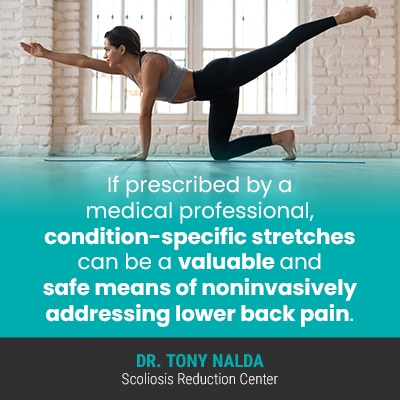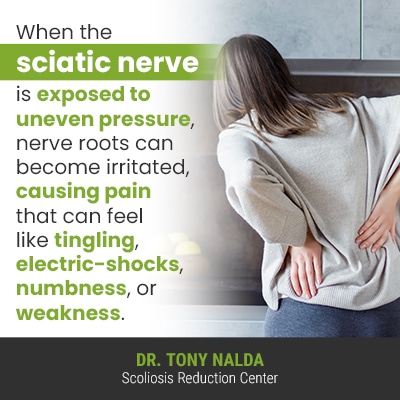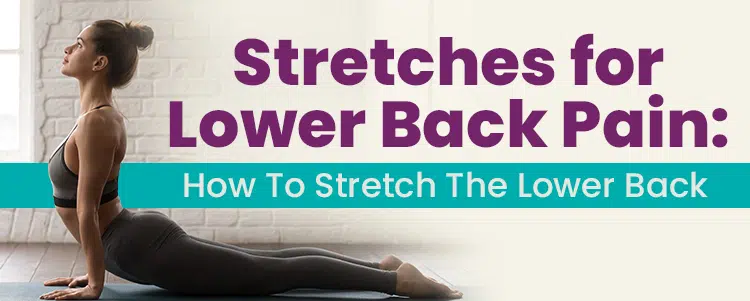There are three main spinal sections: cervical (neck), thoracic (middle/upper back), and lumbar (lower back). When the lower back gets stiff, it can become painful, and a lack of movement can be a causative source. Stretching can help alleviate stiffness and pain, keep the lower spine and its surrounding muscles strong, loose, and flexible.
The lower back (lumbar spine) is important because it supports the thoracic and cervical sections above and bears the brunt of the body’s weight. Knowing how to stretch the lower back can help keep the spine and its surrounding muscles loose, strong, and flexible.
Let’s start our discussion of effective stretches for lower back pain by first expanding on the lumbar spine’s role, and common causes of lower back pain.
4 Key Takeaways
- The Role of the Lumbar Spine: The lumbar spine plays a crucial role in supporting the body’s weight and maintaining overall spinal health. Stretching can alleviate stiffness and pain, contributing to the strength, flexibility, and function of the lower back.
- Common Causes of Lower Back Pain: Lower back pain can stem from various factors, including muscle strain, disc deterioration, and spinal conditions. Identifying the underlying cause is essential for prescribing effective and safe stretches.
- Effective Stretches for Lower Back Pain: Stretches like the Child’s Pose, Knee-to-Chest Stretch, and Piriformis Stretch are effective for relieving lower back pain. They help keep the lumbar spine and surrounding muscles strong, loose, and flexible.
- Proactive Approach to Lower Back Health: While stretching provides symptomatic relief, addressing the underlying cause of back pain through a comprehensive treatment plan is vital for long-term spinal health and function.
The Lumbar Spine and Lower Back Pain
The spine’s natural curvatures make it stronger, more flexible, and better able to absorb/distribute mechanical stress.
The spine is made up of vertebrae (bones) stacked on top of one another in a straight and neutral alignment, and all of these vertebrae, plus the core muscles, work together to maintain the spine’s natural curvatures and alignment.
The lumbar spine is the lower portion of the back that starts at the last thoracic vertebra (T12) and ends at the top of the sacrum (triangular-shaped pelvic bone).
While most people have 5 lumbar levels (L1-L5 vertebral bodies), some have 6, and the lumbar spine’s natural and healthy spinal curve bends inward towards the body’s center in a C-shaped curve, known as lordotic (lordosis). Curves that bend outwards, away from the body’s center are known as kyphotic (kyphosis).
Intervertebral discs are key structures of the spine; they sit between adjacent vertebrae providing structure, flexibility, and act as the body’s shock absorbers.
The discs are made of a tough outer layer and a soft gel-like interior. It’s often the spinal discs that are the first structures to show signs of deterioration, and unhealthy discs can become desiccated, bulging or herniated.
Common Causes of Lower Back Pain
There are many different causes of back pain, one of which is when the lower spine’s lordosis becomes over-or under-pronounced, meaning the lumbar spine has lost its healthy natural curvature and is replaced by an unnatural curve that can disrupt the spine’s overall biomechanics.
There are also a number of spinal conditions, including scoliosis, that involve a loss of the spine’s healthy curves and the development of unhealthy ones.
Lower back pain can range in severity from mild and intermittent to chronic and debilitating, and as the spine has to support the weight of the body’s trunk and the spinal sections above, it’s the section most likely to experience pain and discomfort.
In addition, nerve-related back pain is known as one of the most debilitating forms of back pain, so pain levels often depend on the degree of nerve involvement.
Sciatica, for example, is a condition that involves pain felt along the pathway of the sciatic nerve that starts in the lower back, extends down the buttocks, legs, and into the feet.
When the sciatic nerve is exposed to uneven pressure, nerve roots can become irritated, causing pain that can feel like tingling, electric-shocks, numbness, or weakness.”
Some of the most common causes of lower back pain include muscle strain, lumbar degenerative disc disease, a herniated lumbar disc, lumbar spinal stenosis, sacroiliac joint dysfunction, isthmic spondylolisthesis, facet osteoarthritis, or a compression fracture.
To be clear, no lower back stretches should be attempted as a remedy for pain relief until the underlying cause of the pain has been diagnosed and treated effectively; that way, stretches can be prescribed to address the specifics of a patient’s pain and condition.
It’s particularly important to be prescribed specific stretches by a specialist when a structural condition like scoliosis is the cause of lower back pain, as certain movements/activities/stretches can exacerbate the complex spinal condition.

If prescribed by a medical professional, condition-specific stretches can be a valuable and safe means of noninvasively addressing lower back pain.
So what types of stretches for lower back pain are known to be the most effective at stretching the lower back?
3 Stretches for Lower Back Pain
While there is a wide range of stretches for lower back pain to choose from, not all are created equal; the following are 3 popular, effective, and noninvasive stretches for lower back pain that can help stretch and strengthen the lumbar spine and its surrounding muscles.
1) The Child’s Pose
The child’s pose is a popular traditional yoga pose that gently stretches the gluteus maximus, thigh muscles, and the spinal-extensor muscles.
When performed as prescribed, the stretch can help reduce pain and adverse spinal tension along the spine, neck, and shoulders; while the spine has distinct sections, each is dependent upon the health of the others, so reducing spinal tension along the upper spine can also work to relax and loosen tight lower-back muscles.
Loosening muscles and relieving tension facilitates flexibility and optimal circulation around the spine.
Steps for child’s pose
- Place hands and knees on the ground and rock backwards through the hips to sit on the heels.
- Hinge forward at the hips as you rock forwards and walk the hands out in front in extension.
- Touch the stomach to the thighs.
- Extend the arms alongside the body, or in front of the body, with the palms facing up.
- Focus on breathing and relaxing, particularly focus on areas of the body that are tense and/or tight.
- Hold the pose for up to 1 minute and repeat throughout the day as stiffness increases, or between other stretches.
2) Knee-to-Chest Stretch
The knee-to-chest stretch can help relax the hips, glutes, and thighs while relaxing the body.
Stretches that open up and work the hips are known as hip flexor stretches and offer many benefits: increased hip flexibility, a longer stride, decreased swayback (excessive inward spinal curvature), and reduced lower back, hip, groin, and/or knee pain.
Steps for knee-to-chest stretch
- Lie flat on the back with both knees bent and straight on the floor.
- Pull the right knee up and into the chest, using your hands to clasp around the back of the thigh or front of the shinbone.
- Keep the left leg extended straight and flat on the floor.
- Focus on breathing and releasing tension.
- Hold pose for up to 1 minute.
- Repeat with the left leg.
3) Piriformis Stretch

The piriformis muscle is found deep in the buttocks, and stretching this muscle can help reduce pain and/or tightness in the buttocks and/or lower back.
The large and powerful muscle facilitates hip flexibility and stability and, along with the other hip rotators, turns the hips and upper legs during movement; keeping the large muscle loose with a piriformis stretch can have many benefits.
Hip rotators that are kept strong and flexible facilitate optimal hip- knee-joint alignment; they also stop the knee from suddenly twisting and getting injured during certain movements.
So a strong and flexible piriformis muscle is not only needed for healthy hips, but also plays a role in how well additional hip rotators function and protect the hip and knee joints from injury.
Piriformis stretch steps
- Lie down with both knees bent and back and feet flat on the floor.
- Place the right ankle at just above the knee of the left leg.
- With the hands behind the left thigh, pull upwards toward the chest until a stretch is felt.
- Hold for up to 1 minute.
- Alternate legs.
Conclusion
Knowing how to stretch the lower back effectively can be helpful for those suffering from lower back pain; however, it’s equally important to first determine the underlying cause of the pain.
While there are no treatment guarantees, in terms of treatment efficacy, there is a big difference between treating a symptom, or the underlying condition itself.
It’s also important to ensure that any stretches attempted are first cleared by a medical professional so they can be customized to address important patient/condition characteristics, and to ensure they don’t exacerbate any symptoms.
There are many reasons lower back pain can develop including muscle strain, intervertebral disc issues, and a variety of spinal conditions, including scoliosis.
Once the underlying cause has been determined, when combined with other forms of proactive treatment, stretches for lower back pain can help with pain relief, strengthening the spine, and its surrounding muscles.
As the spine’s very design is based on movement, many of its parts, such as its intervertebral discs, depend on movement to increase circulation in the area: the means by which the discs absorb nutrients.
By keeping the spine’s surrounding muscles as loose and flexible as possible, tight and stiff muscles can be prevented, which is a common cause of muscle strain/injury and back pain.
Healthier muscles are also better able to provide the spine with crucial support/stabilization.
Some popular and effective stretches for lower back pain include the child’s pose, knee-to-chest stretch, and the piriformis stretch.
Knowing how to stretch the lower back can be a noninvasive strategy for managing lower back pain, keeping the spine strong and flexible, and its surrounding muscles loose and strong.
Here at the Scoliosis Reduction Center®, I have treated a wide range of spinal conditions, many featuring lower back pain as the main patient complaint, and by addressing the pain’s underlying cause with proactive treatment, we can make a big difference to patients’ quality of life.





